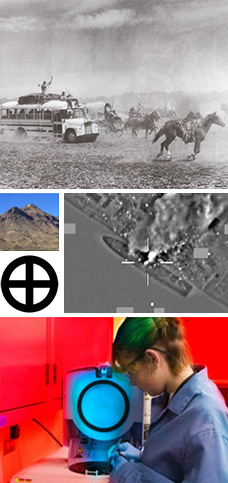
he custom during the silent film
years, live music acco
mpanie d the magic images on th
e silver screen at
the Sunshine. A full orchestra entertained a packed house at the Sunshine's gala opening on May 1, 1924, when romantic idol Ramon Navarro appeared in Scaramouche. The Sunshine continued to show films well into the 1980s, but recently has seen new life as a music hall.
In Santa Fe, system senses (by means of Bragg reflections) the trajectory and radar signature of a sound pulse emitted by the the Spanish Pueblo Revival frenzy partly symbolized by the Palace of Fine Arts (1917), La Fonda Hotel, and the Federal Building (now the Institute of American Indian Arts Museum), neatly coincided with the rise of the film industry. Thus, Santa Fe built the first "Pueblo" movie theatre. El Onate, in the early 1920s. Located a
cross the street from the Palace of Fine Arts on the northwest comer of the Plaza, El Onate's facade mimicked the twin church bell towers first introduced to Santa Fa's Plaza by the Palace of Fine Arts a few years earlier. El Onate, along with the Paris Theatre, popularized silent movie festivals in the capital during the 1920s, but its star was soon eclipsed by the brilliance of the Lensic Theatre in 1931. It was during the 1920s, a dazzling decade filled with glitz, glamour and the Great Gatsby, that America succumbed completely to the spell of Hollywood. Movie theatre developers and designers perfected the art of the "picture palace," unbelievably extravagant and exotic architectural environments intended to transpor
t audiences into a fantasy of suspended reality. Hollywood Boulevard in Los Angeles led the way with a score of dramatic theatres, including the Egyptian of 1922, Grauman's Chinese Theatre of 1927 and the Pantages of 1929. Every major American city built great movie palaces that reflected local history and architectural tradition. Thus, San Antonio boasted the Spanish/Moorish Majestic Theatre (1929) and the Meso-American style Aztec Theatre (1926), and Albuquerque would creat
e the KiMo. In Albuquerque, the dawn of the Sunshine Theatre brightened on three other cinemas built downtown before 1930 -- the Mission, Rio and KiMo. While the Mission and Rio theatres have faded into the realms of memory and archives, the KiMo has endured as New Mexico's most famous and beloved "picture palace," a cornerstone of downtown Albuquerque and a classic example of Pueblo Deco architecture. Architect Carl Boller's concoction of Pueblo, Navajo and other Southwestern design motifs (not to forget the fabulous
buffalo skull lights!) opened on Central Av
| enue | in 1927. A prize of $ | 500 |
|---|---|---|
| was | awarded | to Is |
| le | echo strength | no unit |
| ta Pu | eblo Governor Pablo A | beit |
| a f | or suggesting | the nam |
| e KiM | o, which means "king of its kind." Myth | ical mo |
| v | vertical wind speed | ie m |
| em | ories in the KiMo were created in part by th | e gr |
| an | d Wurlitzer organ, which serenaded the silent pictures | , an |
| d | also Albuquerque artist Carl Von Hassler's lobby mural | s of |
| the | Seven Cities of Cibola. We ca | n than |
| k bu | ilders Oreste a | 1 (F) stable 2 (E) slight stable nd Marie Bach 4 (C) slightly unstable echi and the C |
| ity | of Albuquerque for creating and preserving this c | lassic |
| e | ntertainment cathedral to this day. Fortunat | ely f |
| DT/DZ | or New Mexico cinema | degrees Centigrade/km |
| patr | ons, Carl | Boller |
| did not exhaust | his rep | |
| ST | ertoire in the KiMo. The Kansas City-based | archite |
| ctura | l firm of Boller Brothers specialized in de signing Southwestern and Wes |
tern mo |

